

Present Continuous – Part 3. Are you doing your homework or writing a letter?
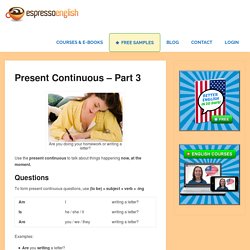
Use the present continuous to talk about things happening now, at the moment. Questions To form present continuous questions, use (to be) + subject + verb + -ing Examples: Are you writing a letter? You can put a question word at the beginning: Present Continuous – Part 1. She's studying physics at the moment.
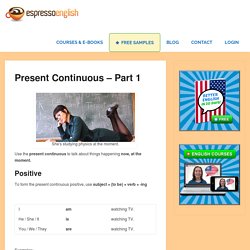
Use the present continuous to talk about things happening now, at the moment. Positive To form the present continuous positive, use subject + (to be) + verb + -ing Examples: “What are you doing now?”
Verb to be in present tense. When I was looking for some materials to teach the present simple tense of the verb to be I was rather unpleasantly surprised by the fact that there are very few speaking activities.
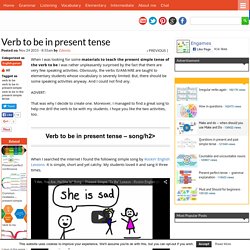
Obviously, the verbs IS/AM/ARE are taught to elementary students whose vocabulary is severely limited. But, there should be some speaking activities anyway. And I could not find any. That was why I decide to create one. Moreover, I managed to find a great song to help me drill the verb to be with my students. Copula verb to be chart . PRESENT PROGRESSIVE WITH MR BEAN. Present Continuous 2. Simple Present - ESL EFL Teaching Resources. Present Simple Dominoes ESL EFL Matching and Speaking Activity - Elementary - 25 Minutes This enjoyable dominoes game is perfect for reviewing the present simple tense.
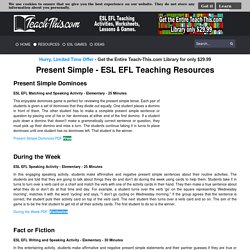
Each pair of students is given a set of dominoes that they divide out equally. One student places a domino in front of them. The other student has to make a complete present simple sentence or question by placing one of his or her dominoes at either end of the first domino. Present Continuous Progressive - ESL EFL Teaching Resources.
Doing it Right ESL EFL Writing and Speaking Activity - Elementary - 30 Minutes This enjoyable worksheet is perfect for teaching your students about the present continuous tense.
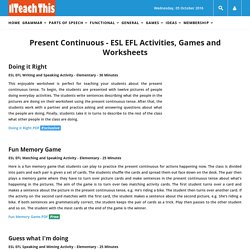
To begin, the students are presented with twelve pictures of people doing everyday activities. Grammar - Present simple or present continuous? Use of the Simple Present.
The difference between present simple and continuous tenses. I have already created two posts on the difference between the present simple and continuous tenses.
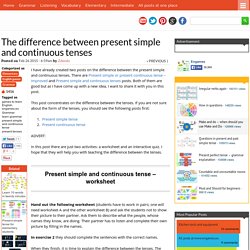
There are Present simple or present continuous tense – improved and Present simple and continuous tenses posts. Both of them are good but as I have come up with a new idea, I want to share it with you in this post. This post concentrates on the difference between the tenses. If you are not sure about the form of the tenses, you should see the following posts first: In this post there are just two activities: a worksheet and an interactive quiz. Present simple tense for elementary students. Present simple is one of the most important tenses in English.
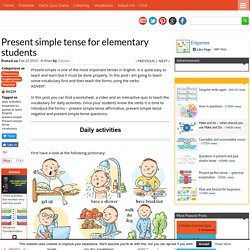
It is quite easy to teach and learn but it must be done properly. In this post I am going to teach some vocabulary first and then teach the forms using the verbs. ADVERT: In this post you can find a worksheet, a video and an interactive quiz to teach the vocabulary for daily activities. Present Simple (English Grammar in Use) –[Multimedia-English videos] Present continuous tense. Today I experienced the great teaching moment when one of my not so proficient students said that she can understand the grammar perfectly and that it is really easy.

I was exalted. I was teaching present continuous tense and the students really liked it and at the end of the lesson they were able to form the affirmative sentences correctly. In this post I would like to share all the activities I used to achieve this. There are an infographic explaining the grammar, a worksheet and an interactive quiz. I hope you will like it. Please, if you spot a mistake leave a comment and I will try to correct it as soon as possible. THE PRESENT SIMPLE TENSE- English Course- Lesson 1- NEW! Adverbs of frequency. Teaching adverbs of frequency has to consist of several steps.
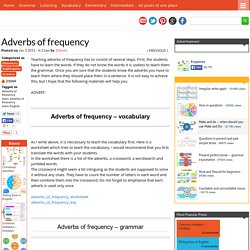
First, the students have to learn the words. If they do not know the words it is useless to teach them the grammar. Once you are sure that the students know the adverbs you have to teach them where they should place them in a sentence. It is not easy to achieve this, but I hope that the following materials will help you. Adverbs of frequency – vocabulary As I write above, it is neccessary to teach the vocabulary first. Adverbs_of_frequency_worksheetadverbs_of_frequency_key Adverbs of frequency – grammar. Present Tense Verbs in Third Person - English Grammar. Normally in the present tense we add S to the end of the verb in the 3rd person (He, She, It).
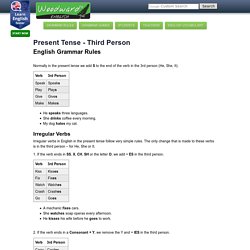
He speaks three languages. She drinks coffee every morning. My dog hates my cat. Irregular Verbs. Spelling 3rd Person Singular Verbs. The Present Progressive Tense. Spelling Tip Verbing (Present Participle) Add ing to most verbs. Ex. play > playing, cry > crying, bark > barkingFor verbs that end in e, remove the e and add ing. Ex: slide > sliding, ride > ridingFor verbs that end in ie, change the ie to y and add ing. Ex: die > dying, tie > tyingFor a verb whose last syllable is written with a consonant-vowel-consonant and is stressed, double the last letter before adding ing. The Present Simple Tense. Spelling Tip In the present simple 3rd person singular (he, she, it), add s, es, or ies to the base form of the verb. To regular verbs just add an s – Ex: travel >travels, give > gives, play >playsTo verbs that end in s, ss, sh, ch, x, and o, add an es – Ex: wash > washes, mix > mixes, go >goesTo verbs end in y after a consonant (any letter that isn’t a vowel), change the y to i and add es.
Ex: study > studies, fly > flies. Present Continuous. [am/is/are + present participle] Examples: You are watching TV. Are you watching TV? You are not watching TV. Esl Simple Present Tense Page 1 - Two Minute English. Learning English 2 Minutes at a Time. Facts, Routine, Habits - The Simple Present - English Lesson. Complete chart verb to have got British and American american. Present continuous, progressive o dynamic.Guía en español. Presente Simple de Verbos Comunes. Learn English with videos. Simple present lesson (LearnAmericanEnglishOnline) Sensory verbs (Steve Ford) Steve Ford will teach you how to use sensory verbs and what is the correct tense to use with them. for the eyes: see / lookfor the ears: hear / listenfor the nose: smellfor the tongue: taste (not on the video) for the hands, etc: feelThis last sensory verb is not explained on the video so we will explain it here:
Simple present tense (SuccessCDS) Present simple or present continuous tense - improved. I have already published a post on Present simple and continuous tense here. However, as my teaching situation changed I realize that I need a slightly different type of materials and a bit more of them. So in this post I add the following materials: a Song, Speaking exercise, graphical explanation of the usage of the tenses, three interactive games and a worksheet. I hope you will find these materials really useful. Present simple and continuous tenses. Many elementary students feel they cannot see the difference between these two tenses. To help them I have created a rap which explains the grammar and gives some example sentences, two mind maps explaining everything simply and several games to practise this grammar point.
Present simple and continuous tenses. Present progressive exercises. Two presents: present continuous, present simple-English. Simple Present vs. Present Continuous Tense. PRESENT SIMPLE OR PROGRESSIVE. Present Simple or Present Continuous 1. Present Simple or Present Continuous? PRESENT SIMPLE VS PRESENT CONTINUOUS REVISION. Present Progressive Tense. Simple Present Tense. Simple Present. [VERB] + s/es in third person Examples: You speak English. Do you speak English? You do not speak English.